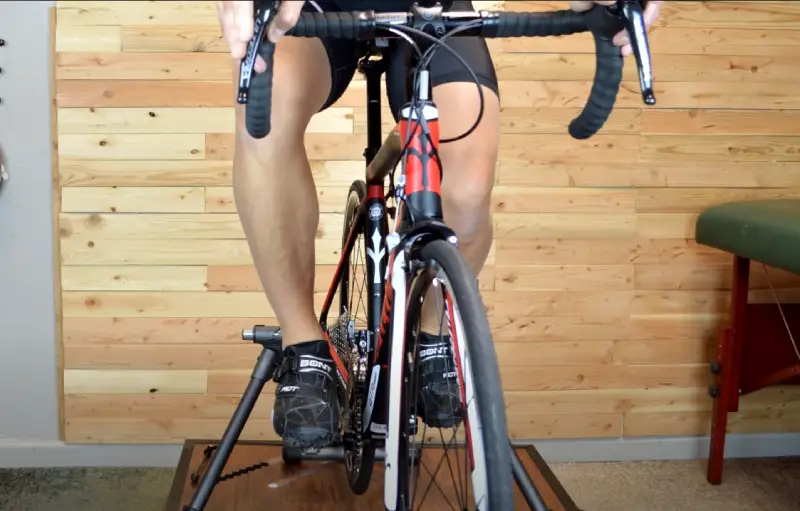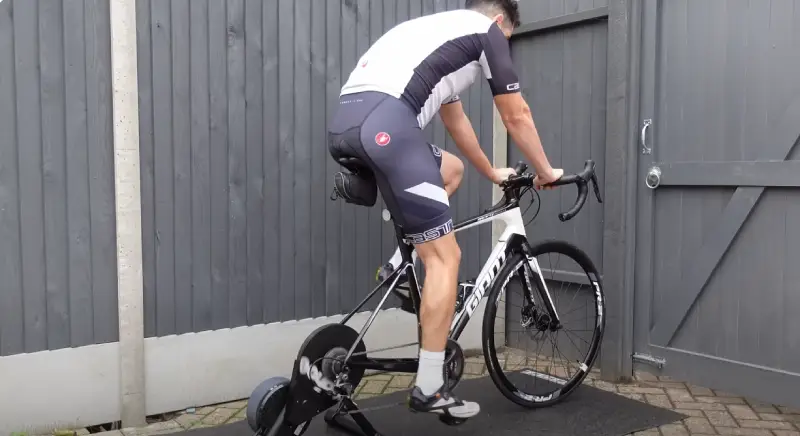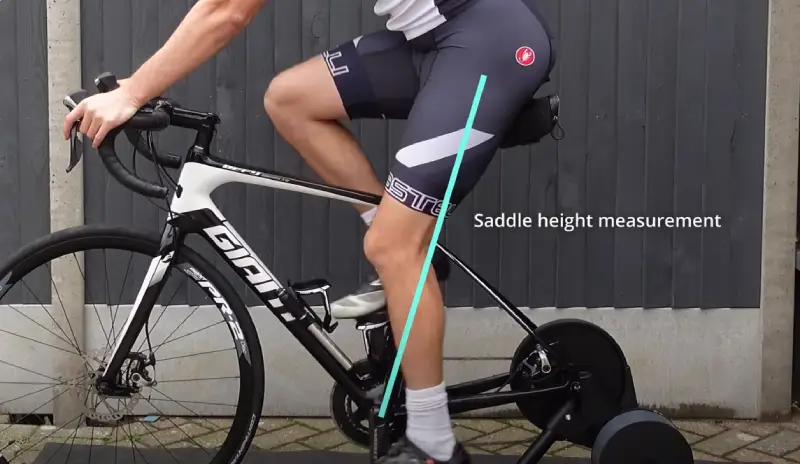Leg pain can arise from various factors beyond underlying diseases. It may result from intense physical activity, a sedentary lifestyle, prolonged standing, cycling-related injuries, or muscle strains.
Yes, gas can cause leg pain for cyclists because of shortened and weakened cycling muscles pressuring the sciatic nerve, causing pain or numbness in the legs.
This can cause sciatica, leg pain from muscle fatigue, oxygen depletion, lactic acid buildup, and inflammation. Ensure proper hydration, rest, and recovery to prevent leg pain while cycling.
In this blog post, we will examine 4 gut-muscle connection effects of gas on cyclists, 3 specific causes of discomfort, and 4 strategies to prevent gastrointestinal distress.
Can Gas Cause Leg Pain For Cyclists: 4 Factors & 4 Solutions

Gas-related discomfort is joint among cyclists, but its potential impact on leg pain is less explored. In this discussion, we delve into the intricate interplay between gastrointestinal issues, particularly gas and leg pain, experienced by cyclists.
We aim to show how gas-related issues may contribute to or exacerbate leg pain during cycling sessions by uncovering four essential gut-muscle effects.
Integrating The Digestive And Muscular Systems
When we think about cycling, our focus often zooms in on leg strength, stamina, and the bike itself. Your digestive system plays a key role in how well you pedal.
Yes, that’s right. The health of your gut and what’s happening inside it can influence your muscle performance, including those all-important leg muscles.
- The Body’s Inner Workings: Your digestive and muscular systems are more connected than you think. When your gut is upset, it can send signals that mess with your muscles to work.
- Gas and Bloating: Have you ever felt bloated or gassy and noticed your legs feeling weirdly sore or cramped? That’s not a coincidence. Gas can cause discomfort that feels like it’s spreading, even to your legs.
Impact Of GI Distress On Cyclists
Riding a bike isn’t just physically demanding; it also shakes things inside your body, especially if you’re pushing hard or for a long time. Here’s how this internal turmoil can mess with your ride:
- Performance Dips: If your stomach is in distress, it’s not just uncomfortable. It can make you slower and less potent on your bike. Your body is too busy dealing with the tummy trouble to give it all to your muscles.
- Cyclist-Specific Issues: Cyclists’ constant movement and physical strain can lead to more frequent GI complaints. Think about it—when you’re hunched over, pedaling hard, your stomach is squished and jostled.
GI Problems Stem From Dehydration And Pacing
Two significant factors that can throw your gut (and thus your muscles) out of whack while cycling are not drinking enough water and pushing too hard without breaks.
- The Role of Water: Staying hydrated helps everything in your body run smoothly, including digestion. When you’re dehydrated, your risk of cramps and discomfort goes up–in your stomach and your legs.
- Finding Your Pace: Going too hard and fast can shock your digestive and muscular systems. It’s like expecting your body to sprint before it’s warmed up–something will protest, and often, it’s your stomach.
Scientific Backup: What Research Says
Studies have shown that exercise, incredibly intense or long-duration activities like cycling, can indeed stir up gastrointestinal issues. This isn’t just “in your head”–there’s actual science behind why your stomach might act up when trying to set a new personal best.
- Exercise-Induced GI Complaints: Research by the National Center for Biotechnology Information (NCBI) highlights that gastrointestinal complaints are common among athletes, especially during exercise. This includes symptoms like gas and bloating, which can lead to unexpected leg pain.
Cyclists Navigating Uncommon Causes of Discomfort: 3 Specific Conditions
Cycling is known for its heart benefits and sense of freedom. Cyclists face physical challenges, from muscle fatigue to specific conditions causing discomfort or pain. Let’s explore lesser-known issues cyclists may encounter, discussing causes, symptoms, and links to cycling dynamics.
The Mystery of Maximal Exercise-Induced Leg Pain
In the realm of competitive cycling, pushing one’s limits is part of the quest for excellence. This drive for peak performance can sometimes lead to unexpected physical responses:
- Causes: Cyclists often experience gut problems due to two main factors: heightened sympathetic nervous system activity during exercise and decreased blood flow to the gut. The risks escalate with higher intensity and prolonged exercise sessions.
- Case Study Insight: There have been documented cases where competitive cyclists experienced significant leg pain tied directly to periods of maximal exertion.
- Understanding the Condition: This type of leg pain is thought to arise from the intense demands placed on the muscles, potentially leading to overuse injuries or exacerbated underlying conditions.
Gas Pedal Knee: A Cyclist’s Nemesis

The term “gas pedal knee” might sound peculiar outside automotive contexts, but it holds relevance for cyclists because of the repetitive motion involved in pedaling:
- Symptoms and Causes: Cyclists may experience pain around the knee, often linked to the constant push-and-pull action during biking. This condition mirrors the stress on a driver’s knee when frequently pressing the gas pedal.
- Relation to Cycling: Inadequate bike fit or improper pedaling technique can exacerbate the knee strain, leading to or aggravating this condition.
Inner Thigh Pain: When Bike Fit Matters
Inner thigh pain is a complaint that can perplex many cyclists, with its origins not always immediately apparent:
- Common Cause: This discomfort can stem from several sources, including chafing because of clothing, muscle strains, or issues related to the bike’s fit—mainly if the height or position forces the cyclist into an unnatural posture.
- Bike Fit Issues: An improperly adjusted bike can cause riders to unnecessarily overextend or contract their inner thigh muscles, leading to pain. Ensuring a proper bike fit is crucial in preventing this type of discomfort.
Gastrointestinal Distress Among Cyclists: 4 Prevention Strategies
Cycling, with its demands on endurance and strength, can sometimes lead to gastrointestinal (GI) issues and discomfort if not appropriately managed. Fortunately, there are proactive measures cyclists can take to minimize these disturbances and ensure a more comfortable and practical ride. Here’s how to keep stomach upset at bay and maintain optimal health on and off the bike.
Dietary Recommendations for Minimizing GI Distress
What you eat before and during your ride can significantly impact your digestive comfort. Here are some tips to keep your stomach settled:
- Pre-Ride Meals: Opt for easily digestible foods a few hours before cycling. Bananas, oatmeal, and yogurt are excellent choices that provide energy without overwhelming your stomach.
- During the Ride: If you’re going on a long ride, bring snacks high in carbohydrates but low in fiber, fat, and protein to avoid digestion issues. Energy gels, bars, and even white bread sandwiches with simple fillings can work well.
- Avoid Known Irritants: Avoid spicy foods, excessive caffeine, and high-fiber items close to your riding time, as they can trigger GI distress.
Hydration Techniques for Digestive and Muscular Health
The importance of hydration cannot be overstated to prevent GI issues and muscle cramps. Here’s how to stay properly hydrated:
- Start Hydrated: Begin your ride well-hydrated. Drink water consistently in the hours leading up to your ride.
- Hydrate During the Ride: Use a water bottle that’s easy to access while riding, and take small sips regularly, rather than waiting until you’re thirsty.
- Electrolyte Balance: For longer rides, consider using electrolyte replacement drinks to maintain electrolyte balance and prevent dehydration and cramping.
Posture and Equipment Adjustments

The way you sit and position yourself on your bike can affect your abdominal comfort and overall riding experience:
- Optimal Saddle Height: Ensure your saddle is at the right height to prevent overextension or compression of your abdomen, which can contribute to discomfort.
- Handlebar Position: Adjusting your handlebars for a comfortable reach can help maintain a posture that reduces strain on
your back and abdomen. - Clothing Choices: Wear fitted but comfortable cycling attire that doesn’t constrict your abdomen or thighs, allowing for better circulation and digestion.
Regular Training and Pacing
The gradual increase in the intensity and duration of your rides can help your body adapt more efficiently, reducing the likelihood of GI distress:
- Build Up Slowly: Incrementally increase your mileage and intensity over weeks to allow your digestive system to adjust to the exertion levels.
- Listen to Your Body: If you feel GI discomfort, consider easing your pace or taking a break. Pay attention to your body’s signals.
Conclusion
So there it is, fellow cycling fans- a surprising insight into how gut health affects cycling performance. Who knew gut health could affect leg pain? Exploring how gas and hydration influence our feelings on two wheels has been quite the journey.
But the journey continues. With this new knowledge, we can make changes that extend beyond cycling. By listening to our bodies, eating mindfully, staying hydrated, and maintaining proper cycling posture, we’re not just preparing for better rides but promoting a healthier lifestyle.
Join the cycling community to share experiences and tips on managing GI distress for smoother rides. Let’s conquer climbs with determination and gut health in mind.
FAQs
What Causes Leg Cramping In Cyclists?
Heat, particularly when cycling in a hotter climate than you’re accustomed to, such as during a sport on the continent, can significantly impact your performance. A warmer climate can subject your body to heat stress, causing increased sweating, faster cooling of your core temperature, and a higher likelihood of experiencing cramps.
What Helps Reduce Leg Pain After Cycling?
Gentle recovery exercises boost blood circulation to achy muscles and could trigger endorphin release to alleviate DOMS-related discomfort. While research outcomes vary, active recovery offers temporary pain alleviation. Such activities encompass light workouts, stretching, and foam rolling.
Can Stomach Gas Cause Leg Pain?
Yes, stomach gas can cause leg pain. The proximity of nerve pathways allows pain to radiate from the stomach to the legs. Gas accumulation in different areas of the intestines can mimic symptoms of conditions like heart disease, gallstones, or appendicitis.
What Are The Symptoms Of Gas Pedal Knee Pain?
Gas pedal knee pain symptoms include pain when bending or straightening the leg, discomfort while walking, jumping, or running, and tenderness at the base of the kneecap.
Are You Sensing Leg Pain When You Press The Gas Pedal?
Yes, leg pain when pressing the gas pedal can occur due to the repetitive movements involved, leading to the gas pedal knee or patellar tendinitis. This condition results from the strain on the tendon connecting the kneecap to the shin bone.

![Cycling Leg Pain: 4 Gut-Muscle Connection Conditions [and 4 Prevention Strategies]](https://cacyclinghub.com/wp-content/uploads/2024/05/Can-Gas-Cause-Leg-Pain-For-Cyclist-e1717563628254.webp)
